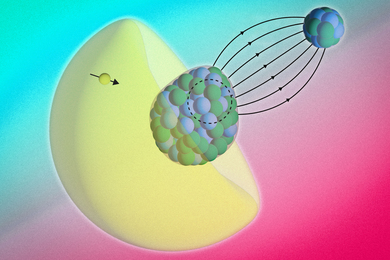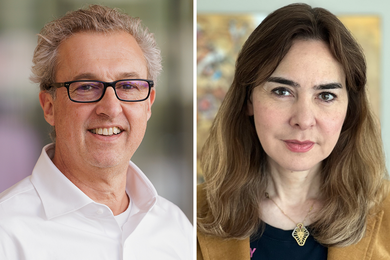Peter A. Wolff, professor emeritus of physics, a semiconductor research pioneer, visionary science administrator and an indispensable guide for MIT physicists seeking careers in industry, died on Sept. 5 due to complications from Alzheimer’s disease. A native of Oakland, Calif., and a longtime resident of Cambridge, Wolff was 89.
“Wolff served the MIT community extraordinarily well for more than 30 years,” says Marc Kastner, dean of the School of Science and the Donner Professor of Science at MIT. “In addition to his own research contributions, Peter laid the foundation of what has become one of the strongest condensed matter physics efforts in the world.”
Wolff’s focus within condensed matter physics was on the physics of metals, insulators and, especially, semi-conductors, whose properties form the core technology of all electronics, from computers to solar cells.
His research career began at Bell Laboratories in the 1950s, just after the transistor was invented; his work there retains significance today. Physicists continue to cite his 1961 paper — co-authored with 1972 Nobel Laureate and MIT alumnus J. Robert Schrieffer ’53 (physics) — about 25 times a year, and his scientific legacy continues at MIT. “The most important work of my own group is on the Kondo problem in semiconductor nanostructures, which is one connection of my work with his,” Kastner says.
In work that began in the 1960s at Bell Labs and continued into the 1990s, Wolff also developed the theory of how light interacts with unpaired electron spins in semiconductors, and he made important contributions to the behavior of plasmas in metals, especially at metal surfaces.
In a co-authored 1998 paper, Wolff showed that a metal film with holes in it could transmit light efficiently, even when the wavelength of the light is much larger than the size of the holes. “This was completely unexpected,” Kastner says.
Wolff showed that this could be explained theoretically using the interaction between the light and the plasma in the metal at the surface. The 1998 publication is still cited more than 200 times annually.
“As a scientist, he appreciated the importance of basic and of broadly applied research,” says Robert Birgeneau, former dean of the School of Science at MIT. “His research experiences in academe and in industry were great resources for students.”
A visionary leader for MIT physics
Wolff joined the MIT faculty in 1970, charged with teaching, conducting research and establishing condensed matter physics — then known as solid-state physics — as a new discipline within the department. Within three years, he had successfully applied his industry management experience to academic life.
He assembled a world-class research group, hiring Kastner in 1973; John Joannopoulos, now the Francis Wright Davis Professor of Physics and director of the Institute for Soldier Nanotechnologies, in 1974; and, in 1975, Birgeneau, who recently served as chancellor at the University of California at Berkeley.
Joannopoulos says he felt “extremely fortunate to have Wolff as a mentor to mold and nurture my evolution as a scientist and teacher.”
Wolff’s “easy-going personality, altruism, wisdom and vision were instrumental in creating a working environment that was at once both cutting-edge and extremely collegial,” Joannopoulos adds. “I shall miss him deeply.”
Named director of the Research Laboratory of Electronics in 1976, Wolff supported the hiring of Erich Ippen ’62, the Elihu Thomson Professor of Electrical Engineering and professor emeritus of physics; and Henry Smith, a former professor of electrical engineering and founding director of MIT’s NanoStructures Laboratory.
Wolff’s research impressed Ippen, especially a 1966 paper that presented a theory of light scattering by free electrons in semiconductors. That work was “before its time since no lasers were available then to test the theory,” Ippen says.
Another article — Wolff’s review chapter in the 1977 book "Nonlinear Optics" — has retained importance to Ippen. “That book, well worn, with binding falling apart, is still on the shelf next to my desk at MIT,” he says. “The subject of ultrafast and nonlinear optics with free electrons in semiconductors and metals is important in some photonic applications today.”
Ippen owns another well-worn Wolff memento: the tennis racket he gave Ippen when he stopped playing his regular, ferocious game. Wolff pursued his other passions — hiking, gardening and art — throughout his life.
In fact, Wolff’s passion for art led him to leadership in that area, too. A collector of Native American, Inuit and abstract expressionist art, he actively supported the arts at MIT and served as chair of the MIT Council for the Arts in 1987.
Fostering research innovations
In 1981, Wolff became director of the Francis Bitter National Magnet Laboratory. The “MagLab,” founded in 1963, drew researchers from far beyond the Institute to conduct research requiring the world's most powerful magnets.
Wolff’s flair for fostering successful collaborations among researchers and students flourished during his MagLab years — 1981 to 1987. Always alert to innovative research, he encouraged two Bell Labs physicists, Horst Stormer and Dan Tsui, to conduct groundbreaking experiments at the MagLab facility. In 1998, Stormer and Tsui shared the Nobel Prize in physics with MIT alumnus Robert B. Laughlin PhD ’79 for their discovery and explanation of the fractional quantum Hall effect.
Related to high-energy physics, the fractional quantum Hall effect may help scientists understand the quantum structure of the vacuum throughout the space-time of the universe. Wolff described a classic MIT mix of excitement and risk in launching the trio’s Nobel experiment. Squeezing a large high-field magnet into a tiny space with very low-temperature equipment was a “gamble,” he said in a 1998 Tech Talk interview: “There was a real chance it wouldn't work.”
At one point, “The whole inside of the magnet blew up, and pieces literally hit the ceiling. They thought they had wrecked the equipment, but it survived,” Wolff told Tech Talk. Undeterred, the team went on.
Team-building among scientists and across generations was the core of Wolff’s leadership style: At the MagLab, he both supported Stormer and Tsui in conducting new experiments and arranged their supervision of MIT graduate students working at the lab.
Thanks to Wolff, Greg Boebinger PhD ’86 was one of those graduate students. Now director of the National High Magnetic Field Laboratory at Florida State University, Boebinger recalled his former mentor’s “unswerving focus on two things: getting the science done, and providing opportunities for advancing a junior person’s career. He was a real gentleman and a real gem of a human being.”
The indispensable postgrad guide
Wolff retired from MIT in 1989. He served as a Fellow at the NEC Research Institute at Princeton University from 1989 to 1994, and then returned to the Institute in 1994 as a senior lecturer-emeritus to lead the physics department’s physics and industry forum.
Many of his colleagues feel Wolff’s years of directing graduate students towards industry opportunities were among his most valuable contributions to MIT physics.
In 1996, The Chronicle of Higher Education recognized Wolff and his efforts at MIT in making science doctoral candidates aware of career options outside academia through seminars featuring physicists who worked as management consultants, patent lawyers and business owners.
“Students used to rely on their faculty members to get them jobs,” Wolff told The Chronicle. “What’s out there is changing exceedingly fast. Internships give them valuable contacts.”
Wolff received the bachelor’s and PhD degrees in physics from the University of California at Berkeley in 1945 and 1951, respectively. He is co-author, with P.M. Platzman, of "Waves and Interactions in Solid-State Plasmas" (1973), a textbook still in use today.
Wolff’s wife, artist Catherine Vance Carroll, died in 2000. He is survived by his daughter, Mia, an artist living in New York City; a son, Whitney, of Wayland, Mass., and three grandsons and one granddaughter.
To share stories celebrating Wolff’s life or to express condolences, please visit the memorial website at: forevermissed.com/peter-adalbert-wolff/
“Wolff served the MIT community extraordinarily well for more than 30 years,” says Marc Kastner, dean of the School of Science and the Donner Professor of Science at MIT. “In addition to his own research contributions, Peter laid the foundation of what has become one of the strongest condensed matter physics efforts in the world.”
Wolff’s focus within condensed matter physics was on the physics of metals, insulators and, especially, semi-conductors, whose properties form the core technology of all electronics, from computers to solar cells.
His research career began at Bell Laboratories in the 1950s, just after the transistor was invented; his work there retains significance today. Physicists continue to cite his 1961 paper — co-authored with 1972 Nobel Laureate and MIT alumnus J. Robert Schrieffer ’53 (physics) — about 25 times a year, and his scientific legacy continues at MIT. “The most important work of my own group is on the Kondo problem in semiconductor nanostructures, which is one connection of my work with his,” Kastner says.
In work that began in the 1960s at Bell Labs and continued into the 1990s, Wolff also developed the theory of how light interacts with unpaired electron spins in semiconductors, and he made important contributions to the behavior of plasmas in metals, especially at metal surfaces.
In a co-authored 1998 paper, Wolff showed that a metal film with holes in it could transmit light efficiently, even when the wavelength of the light is much larger than the size of the holes. “This was completely unexpected,” Kastner says.
Wolff showed that this could be explained theoretically using the interaction between the light and the plasma in the metal at the surface. The 1998 publication is still cited more than 200 times annually.
“As a scientist, he appreciated the importance of basic and of broadly applied research,” says Robert Birgeneau, former dean of the School of Science at MIT. “His research experiences in academe and in industry were great resources for students.”
A visionary leader for MIT physics
Wolff joined the MIT faculty in 1970, charged with teaching, conducting research and establishing condensed matter physics — then known as solid-state physics — as a new discipline within the department. Within three years, he had successfully applied his industry management experience to academic life.
He assembled a world-class research group, hiring Kastner in 1973; John Joannopoulos, now the Francis Wright Davis Professor of Physics and director of the Institute for Soldier Nanotechnologies, in 1974; and, in 1975, Birgeneau, who recently served as chancellor at the University of California at Berkeley.
Joannopoulos says he felt “extremely fortunate to have Wolff as a mentor to mold and nurture my evolution as a scientist and teacher.”
Wolff’s “easy-going personality, altruism, wisdom and vision were instrumental in creating a working environment that was at once both cutting-edge and extremely collegial,” Joannopoulos adds. “I shall miss him deeply.”
Named director of the Research Laboratory of Electronics in 1976, Wolff supported the hiring of Erich Ippen ’62, the Elihu Thomson Professor of Electrical Engineering and professor emeritus of physics; and Henry Smith, a former professor of electrical engineering and founding director of MIT’s NanoStructures Laboratory.
Wolff’s research impressed Ippen, especially a 1966 paper that presented a theory of light scattering by free electrons in semiconductors. That work was “before its time since no lasers were available then to test the theory,” Ippen says.
Another article — Wolff’s review chapter in the 1977 book "Nonlinear Optics" — has retained importance to Ippen. “That book, well worn, with binding falling apart, is still on the shelf next to my desk at MIT,” he says. “The subject of ultrafast and nonlinear optics with free electrons in semiconductors and metals is important in some photonic applications today.”
Ippen owns another well-worn Wolff memento: the tennis racket he gave Ippen when he stopped playing his regular, ferocious game. Wolff pursued his other passions — hiking, gardening and art — throughout his life.
In fact, Wolff’s passion for art led him to leadership in that area, too. A collector of Native American, Inuit and abstract expressionist art, he actively supported the arts at MIT and served as chair of the MIT Council for the Arts in 1987.
Fostering research innovations
In 1981, Wolff became director of the Francis Bitter National Magnet Laboratory. The “MagLab,” founded in 1963, drew researchers from far beyond the Institute to conduct research requiring the world's most powerful magnets.
Wolff’s flair for fostering successful collaborations among researchers and students flourished during his MagLab years — 1981 to 1987. Always alert to innovative research, he encouraged two Bell Labs physicists, Horst Stormer and Dan Tsui, to conduct groundbreaking experiments at the MagLab facility. In 1998, Stormer and Tsui shared the Nobel Prize in physics with MIT alumnus Robert B. Laughlin PhD ’79 for their discovery and explanation of the fractional quantum Hall effect.
Related to high-energy physics, the fractional quantum Hall effect may help scientists understand the quantum structure of the vacuum throughout the space-time of the universe. Wolff described a classic MIT mix of excitement and risk in launching the trio’s Nobel experiment. Squeezing a large high-field magnet into a tiny space with very low-temperature equipment was a “gamble,” he said in a 1998 Tech Talk interview: “There was a real chance it wouldn't work.”
At one point, “The whole inside of the magnet blew up, and pieces literally hit the ceiling. They thought they had wrecked the equipment, but it survived,” Wolff told Tech Talk. Undeterred, the team went on.
Team-building among scientists and across generations was the core of Wolff’s leadership style: At the MagLab, he both supported Stormer and Tsui in conducting new experiments and arranged their supervision of MIT graduate students working at the lab.
Thanks to Wolff, Greg Boebinger PhD ’86 was one of those graduate students. Now director of the National High Magnetic Field Laboratory at Florida State University, Boebinger recalled his former mentor’s “unswerving focus on two things: getting the science done, and providing opportunities for advancing a junior person’s career. He was a real gentleman and a real gem of a human being.”
The indispensable postgrad guide
Wolff retired from MIT in 1989. He served as a Fellow at the NEC Research Institute at Princeton University from 1989 to 1994, and then returned to the Institute in 1994 as a senior lecturer-emeritus to lead the physics department’s physics and industry forum.
Many of his colleagues feel Wolff’s years of directing graduate students towards industry opportunities were among his most valuable contributions to MIT physics.
In 1996, The Chronicle of Higher Education recognized Wolff and his efforts at MIT in making science doctoral candidates aware of career options outside academia through seminars featuring physicists who worked as management consultants, patent lawyers and business owners.
“Students used to rely on their faculty members to get them jobs,” Wolff told The Chronicle. “What’s out there is changing exceedingly fast. Internships give them valuable contacts.”
Wolff received the bachelor’s and PhD degrees in physics from the University of California at Berkeley in 1945 and 1951, respectively. He is co-author, with P.M. Platzman, of "Waves and Interactions in Solid-State Plasmas" (1973), a textbook still in use today.
Wolff’s wife, artist Catherine Vance Carroll, died in 2000. He is survived by his daughter, Mia, an artist living in New York City; a son, Whitney, of Wayland, Mass., and three grandsons and one granddaughter.
To share stories celebrating Wolff’s life or to express condolences, please visit the memorial website at: forevermissed.com/peter-adalbert-wolff/






